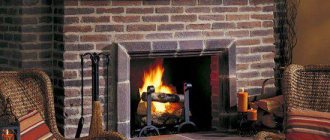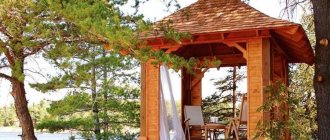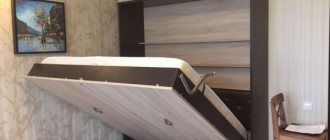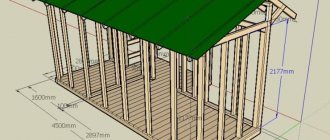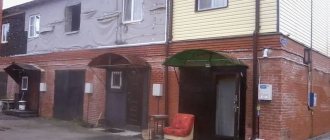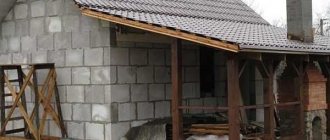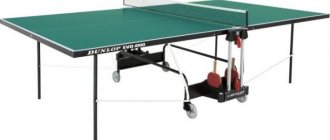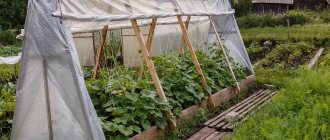Review author: Terrari School of Design
How wonderful it is to have your own home, where you can enjoy the surrounding nature, spend weekends with your family, and relax.
Some people cannot imagine life in the private sector without animals, especially rabbits. These cute pets will not only delight all family members, especially younger ones, with their appearance, but will also bring great benefits.
In order for them to live comfortably and bring offspring, it is necessary to equip their home - a rabbitry. What it should be like, how to make a rabbitry with your own hands - let's look at it in more detail.
Beginning of work
Between the idea of building a rabbitry and its implementation stands the most important design stage. You must study the features of keeping long-eared pets and make the house as comfortable as possible for both the animals and the person who will look after them. Always remember that rabbits are living beings with their own needs.
Having decided on the breed, plan further livestock. The size of the animals, their gender and age make adjustments to the design of the rabbitry. When starting construction, it is better to provide for the possibility of further expansion.
Choose your location carefully. Try to find an area away from sources of loud noise. Give preference to the shady side and elevations: in summer the sun will not cause discomfort to the animals, and in rainy weather water will not flow into the rabbitry. Under no circumstances should it be adjacent to a compost pit.
Nothing should block access to the cells. They themselves should be as spacious and comfortable as possible.
Features of caring for rabbits
There is a common belief that rabbits are prone to various diseases. And if one individual gets sick, the entire population will inevitably die. Hence the reluctance of farmers to breed rabbits. There is a high risk of losing all animals at once and incurring losses.
Experts believe that proper maintenance of rabbits, together with well-chosen balanced feed, reduces the risk of loss of livestock to zero. When well maintained, these rodents reproduce quickly and grow well.
Having decided to start breeding rabbits, you must first take care of the conditions in which the animals will live. A proper rabbitry should be convenient both for rabbits to live in and for caring for.
Size selection
The size of the rabbitry is calculated based on the number, sex and age of its inhabitants.
Adults live in individual cages measuring 100x60 cm. It is important for sexually mature males to have more space, so the parameters can be increased for them.
A mother rabbit needs a cage with dimensions of at least 170x100x60 cm. It is good if her house is in the shade. Install it at a height of 70-80 cm from the ground.
A large pet weighing more than 5 kg requires enough space - at least 130x70x40 cm. The roof can be made sloping by reducing the height of the rear wall by 10-15 cm.
Young animals are kept in groups of up to 20 animals. Groups of 3-5 baby rabbits live in separate buildings for up to 3 months; older animals are kept in batches of up to 4 individuals. The area of the cells should be 50x50x35.
Of course, you have the right to change these parameters to suit your needs, but try not to make the cells smaller. For normal functioning, rabbits, like any living creature, need space.
Stages of making a rabbitry
- Preparatory. Selecting a site for construction and design of the structure. Size calculations, drawing, calculation of required materials. Frame assembly.
- Manufacturing of floor and roof. Make holes in the bottom for supports.
- Installation of shelves, partitions and roofing. Making feeders.
- Manufacturing of mesh doors. Covering the rear and side walls with boards and metal.
- Insulation of houses, installation of doors, locks. For the convenience of servicing animals, it is better to make the door hinged. Foam plastic and plywood are suitable for insulation. It is possible to provide for the installation of an electric heating element under the bottom of the cage.
- Installation of lighting (if necessary). You can install motion and light sensors “day/night”.
Selection of design type
Check out the photos of finished rabbit hutches and see how they are structured.
Considering the number of pets, calculate how many cages you will need and how best to install them. In addition to single and two-section, rabbitry can be:
- Single-tier;
- Multi-tiered;
- With an aviary;
- In the form of an extension to the main room.
Having a clear plan, start building a drawing of the rabbitry. Take into account every little detail: size, location of doors, feeders and drinkers, taking into account the needs of each pet.
How to heat in winter
Sometimes in winter it may be necessary to insulate the cage. You can make heating using felt, old blankets, hay, pine needles. Also, a heat insulator such as polystyrene foam is ideal for external insulation.
A slight frost in itself will not harm the animals; it is important to avoid high humidity in the enclosures. It is necessary to ensure that snow and other precipitation does not get into the cages. For this purpose, sheets of iron are suitable, which can be used to trim the rabbitry from the outside.
Experienced rabbit breeders, without using artificial heating, line the entire cage inside with hay. Rabbits heat it with their breath and it retains heat well. In severe frosts, it is necessary to provide the animals with a more or less warm floor. To do this, the bottom of the cage, if it is metal, is covered with a thick layer of hay. For wooden floors, you can use the above-mentioned ladders, which protect the floor well from freezing.
In severe frosts, you can keep animals in sheds. It is for this purpose that all cages are designed in such a way that they are convenient to carry. There are also heating and water heating projects in winter.
Did you know? Hares are solitary by nature. Rabbits live in groups and are therefore social animals. This is the main difference between these long-eared animals and each other.
Insulation
Rabbits feel comfortable at a temperature of 10-20º. Therefore, for the winter you need to either move the house standing in the fresh air to a warm place, or insulate the existing home.
Cover the door with plywood. It’s even better if you glaze it - this option will allow the animals to receive more sunlight. Add a layer of hay to the wooden flooring. The walls can be insulated with ordinary polystyrene foam.
An alternative approach is to build a special shed with heating. Be sure to make a foundation, and the room itself can be wooden or brick. The main thing is that there are no drafts anywhere. The doors should also fit tightly in their frames and protect the shed from the cold. On the south side, arrange a walking area.
For a summer residence, the second option for organizing a rabbitry is more convenient.
Mini farm
A mini-farm is the most convenient and practical cage for rabbits. Although it is not very easy to do. Experienced farmers spend months building such a cage.
The rabbitry itself is quite large. It can accommodate up to five dozen rabbits. Also, a mini-farm implies full automation and mechanized supply of water and food.
If you are new to farming, we do not advise you to use this method, as it requires large financial investments.
Feeders and drinkers
Wood is usually used to make them. Plastic can be toxic, so it is safer to use classic material.
Place feeders along the long side of the rabbitry. Be careful with the size so that there is no crowding during feeding. Their height is such that animals cannot steal food.
The dimensions of the feeder in the compartment of the female with the rabbits are at least 40x4x4 cm. The presence of retractable compartments will be relevant.
Between the sections of the rabbit house, provide gaps through which it is convenient to feed hay and feed. Through a nursery with an external door, you can offer roughage to the animals.
Attach the drinking bowl to the side wall. A “cheap and cheerful” but effective option is a bowl and a water bottle inverted into it. A small hole is made in the lid. This way, as you drink from the bowl, the drinking bowl will be replenished from the bottle.
Making a rabbitry with your own hands is not difficult. Look at the photo - these could be real cozy houses. If animals feel good without experiencing discomfort, they will grow and reproduce faster, which is what any breeder strives for.
Useful tips
Pros are always ready to share their observations and advice with novice summer residents, which will not only facilitate installation, but also help make the structure durable.
Here are some of them:
- If you want to extend the life of the structure, you can upholster the wooden parts of the frame with metal. It is not necessary to purchase it separately; tin cans or galvanized steel will be sufficient for roofing work. Upholstery will not take much time, and the product will last many years longer.
- Depending on the size of the rabbitry, a different amount of wood will be required. For example, ordinary pieces of wood with a cross-section of 5x5 cm would be an excellent material for making a frame. They are inexpensive and very easy to use.
- Under no circumstances should you use an antiseptic for impregnation. This product is quite toxic and can be fatal to rabbits. Instead, it is helpful to let the frame dry thoroughly. This will also extend its service life.
- To cover the tiers, use a material that will not conduct moisture, such as slate. If the rabbitry is placed outside, there is no need to make a metal roof. It gets very hot in the sun, which can cause discomfort or even kill residents.
- The sheathing of the frame can be made using a chain-link mesh with 2x2 cm cells. And the sides, doors and facade can be made of steel mesh. To make it easier for the animals to get to the food, the feeders into which the grain will be poured should be made of a mesh with 5x5 cm cells. It will be very convenient if they are of a rotating design. This will greatly simplify both filling and cleaning.
- Solid flooring is not recommended, as this threatens to worsen the microclimate in the rabbitry and cause rapid rotting of the wood. So it is best to make the bottom lattice. The material can be planed floor blocks, the gap between which should not be more than 1 cm.
- Drafts are very dangerous for rabbits; these animals easily get sick. To prevent this from happening, the back wall (using polycarbonate, boards, plywood or OSB) is made blank.
- If the building is located outside, then the supporting frame must be metal. You just need to weld such a structure from a 4.5x4.5 cm corner. Next, you should insert the made mesh sections into it. The mesh is fixed to the frames, which are obtained by welding a steel rod. In addition, you can make the frame wooden.
- To prevent the rabbits from developing corns on their paws, which cause severe discomfort, it is worth placing a sheet of plywood on the floor that will protect the animals’ paws. But at the same time, you need to remember that such plywood should be cleaned and dried regularly.
- The net will not be able to protect you from rain or snow; the animals will not be completely protected. So it would be more correct to install the cage under some kind of canopy, or even better, in a barn.
A neat, high-quality and, most importantly, do-it-yourself rabbitry will not only please your furry pets, but will also look great in the photo. And proper care, feeding and maintenance will soon delight you with new healthy offspring.
Benefits of raising rabbits
Rabbit breeding today is an extremely popular area of livestock farming. When organizing the proper conditions for keeping and feeding such animals, the breeder has a wide range of advantages that are inherent in rabbit farms.
The main ones among them are:
- obtaining high-quality fur, which is highly valued in clothing production;
- dietary meat, widely used in cooking;
- the possibility of using the manure of such animals to fertilize fields and vegetable gardens;
- caring for animals requires a relatively small amount of time and money;
- Owners also receive a certain income from the sale of young animals.
Single tier cage
It features a simplified design. A rectangular shape is used, which is installed on bars, which is necessary for comfortable feeding, maintenance and safety of animals.
A pitched roof is used based on the remains of slate, which can be replaced with rolled material. But the slope is necessary for the drainage of rainwater. A tray is mounted at the bottom with a groove for urine drainage, which is convenient for cleaning.
Animal conditions
These rodents are unpretentious in nature, quite mobile, and live in ordinary earthen burrows. However, for both dwarf domestic and industrial (meat, skin) breeds, excessive mobility is not needed, so the cages are made with serious space restrictions.
Modern French rabbit farm
Traditional rabbitry in Spain
Before choosing a specific product, or rather, the size of the future homemade product, you need to consider:
- pet size. Dwarf breeds weigh about a kilogram (or less), the largest (White Giant, German Giant, Giant Ram) weigh 12 kilograms or more. The dimensions of their body, respectively, are from 10...12 to 70 cm. The rabbit must fit freely in the cage, be able to turn around in it, and move in small leaps. That is, the minimum width should be equal to the length of the body, and the length should be no less than three to four times the length of the body. It is believed that for an average-sized rabbit the area should be at least 0.2...0.3 square meters for young animals and approximately 0.5...1 sq.m. for an adult animal;
- the number of pets in the cage and their age. For queens with babies, less space is required than for fattened young animals, but in any case, the minimum cage sizes are determined by the largest of the animals;
- type of content – cellular, semi-free, free. Considering that the article is about cells, we are considering cellular maintenance - it reduces the risk of uncontrolled reproduction, degeneration due to inbreeding, disease and death of animals;
- method of keeping - outdoors, under a canopy, indoors, combined;
Two-tier cages for keeping in a ventilated barn. Please note that for meat breeds the cage sizes are smaller!
- arrangement of cages - separately for each animal, with grouping - a row, several tiers, the so-called shed, that is, a group of cages under a common canopy;
- availability and cost of building materials.
To keep decorative breeds, cages are often purchased or made from scrap materials. To keep meat-hide and downy breeds, products are assembled in batches for the entire population of rabbits, taking into account the increase in quantity. It is advisable to breed downy and valuable fur breeds under a canopy to preserve the quality of the skin.
